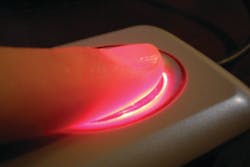Tipping point unclear for mass market adoption of biometrics
One of the biggest questions surrounding the adoption of biometric access control solutions in the security industry for a number of years has been when will the technology reach the tipping point and the answer usually depends on who you ask. Despite decreasing prices, some believe that the technology will always be a niche solution for high-end applications. Others believe the technology will become more prevalent in the future as improvements are made with regards to the accuracy of biometrics and as price points continue to drop.
In an effort to advance identification technologies such as biometrics, manufacturers, along with the government and several universities established the Center for Identification Technology Research (CITeR) in 2002. According to Bojan Cukic, a professor of computer science and electrical engineering at West Virginia University (the center’s founding Industry/University Cooperative Research Center) and site director for CITeR at WVU, companies and government agencies provide funding support for the center and also play a role in selecting and directing the research projects proposed by faculty members at WVU and its affiliate I/UCRC locations at the University of Arizona and Clarkston University in New York.
"The mission of the center is to advance identification technology and it is focused on the areas of biometric systems and credibility assessments," Cukic explained. "In addition to multidisciplinary research in emerging technologies, we also train students, scientists and engineers and facilitate technology transfer to the private and government sectors."
Cukic said that CITeR has been responsible for many significant accomplishments in the progression of biometric technology including having intellectual property developed by CITeR researches used by several small biometric companies, such as algorithms for fingerprint liveness detection, as well as the development of automated tattoo recognition software. Additionally, Cukic said that CITeR researchers have authored more than 400 publications, including seven books, on biometrics, statistical analysis of biometric systems and the ethical uses of biometrics.
While some still question the reliability of biometric solutions, Cukic said he believes that the technology is reliable for the mass market; however, it’s not clear whether or not it will replace existing access control measures in many applications.
"The application of biometrics is still heavily dominated by government mandates," he said. "It is an option for access control in the PC market or laptop market, but we have not seen specific tipping points yet in the other mass markets."
Despite this, Cukic said that the price of biometrics will continue to decline and that the consolidation of companies in the industry will create more opportunities for the technology to be become more widely adopted in the future.
"What you have seen over the past five years is significant consolidation of the industry where many small companies have been acquired by a few larger ones, which are actively pursuing government, as well as commercial applications," Cukic said. "I see the true opportunity for wider adoption in the application of the service model in computing – where biometrics would be available as one of the security services, authenticating or authorizing Internet transactions. However, the prerequisite for that model, which would significantly lower the costs, is true interoperability between biometric sensors and systems, as well as a significant improvement in the types of services offered by the biometric providers as we know them today."
Cukic said that most biometric devices currently available are standalone solutions that do not have access to the Internet. Were this to change, Cukic believes the use of biometrics could receive a significant shot in the arm. "I would say that we have good components, but the question remains, who is going to be the developer responsible for offering these systems in which biometrics address some of the authorization and authentication problems that we face today?" he added.
Though the industry has not settled on a single biometric identifier, Cukic said that there are definitely three leading modalities, which include fingerprint, facial and iris recognition. In fact, Cukic envisions a future where a system will automatically select the best identifier to use.
"I don’t think the market will settle for a single biometric. The acquisition qualities reduce the effectiveness of potentially every modality that we know of today, requiring highly-cooperative users at time when users are not trained anymore to spend too much time cooperating with a device." Cukic explained. "Therefore, I see the major technology trend towards unconstrained acquisition in which systems acquire biometrics over a period of time and select the best quality image or video sequence, rather than wait for the user to essentially provide that one, very high-quality sample."
Eventually, Cukic believes that biometrics will become a regular integrated component of security systems and not an add-on feature. "Biometrics will be a regular part of security solutions, not an appendage to existing, prevalent systems," he said.
About the Author
Joel Griffin
Editor-in-Chief, SecurityInfoWatch.com
Joel Griffin is the Editor-in-Chief of SecurityInfoWatch.com, a business-to-business news website published by Endeavor Business Media that covers all aspects of the physical security industry. Joel has covered the security industry since May 2008 when he first joined the site as assistant editor. Prior to SecurityInfoWatch, Joel worked as a staff reporter for two years at the Newton Citizen, a daily newspaper located in the suburban Atlanta city of Covington, Ga.

